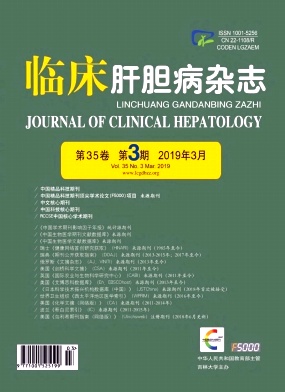|
[1] Fatty Liver and Alcoholic Liver Disease Study Group of the Chi-nese Liver Disease Association, Chinese Medical Association.Guidelines for prevention and treatment of alcoholic liver dis-ease (revised version 2010) [J]. J Clin Hepatol, 2010, 26 (3) :229-232. (in Chinese) 中华医学会肝病学分会脂肪肝和酒精性肝病学组.酒精性肝病诊疗指南 (2010年修订版) [J].临床肝胆病杂志, 2010, 26 (3) :229-232.
|
|
[2] European Association for the Study of Liver. EASL clinical practi-cal guidelines:Management of alcoholic liver disease[J]. J Hep-atol, 2012, 57 (2) :399-420.
|
|
[3] WARREN KR, MURRAY MM. Alcoholic liver disease and pan-creatitis:Global health problems being addressed by the USNational Institute on Alcohol Abuse and Alcoholism[J]. J Gas-troenterol Hepatol, 2013, 28 (Suppl 1) :4-6.
|
|
[4] O'SHEA RS, DASARATHY S, MCCULLOUGH AJ. Alcoholicliver disease[J]. Hepatology, 2010, 51 (1) :307-328.
|
|
[5] MCCULLOUGH AJ, O'SHEA RS, DASARATHY S. Diagnosisand management of alcoholic liver disease[J]. J Dig Dis, 2011, 12 (4) :257-262.
|
|
[6] FAN JG. Epidemiology of alcoholic and nonalcoholic fatty liverdisease in China[J]. J Gastroenterol Hepatol, 2013, 28 (Sup-pl 1) :11-17.
|
|
[7] AKIYAMA K, CHEN C, WANG D, et al. Mesenchymal-stem-cell-induced immunoregulation involves FAS-ligand-/FAS-mediated T cell apoptosis[J]. Cell Stem Cell, 2012, 10 (5) :544-555.
|
|
[8] KUO TK, HUNG SP, CHUANG CH, et al. Stem cell therapyfor liver disease:Parameters governing the success of usingbone marrow mesenchymal stem cells[J]. Gastroenterology, 2008, 134 (7) :2111-2121.
|
|
[9] ZHANG Z, WANG FS. Stem cell therapies for liver failure andcirrhosis[J]. J Hepatol, 2013, 59 (1) :183-185.
|
|
[10] SPAHR L, LAMBERT JF, RUBBIA-BRANDT L, et al. Granu-locyte-colony stimulating factor induces proliferation of hepat-ic progenitors in alcoholic steatohepatitis:A randomized trial[J]. Hepatology, 2008, 48 (1) :221-229
|
|
[11] AURICH H, SGODDA M, KALTWASSER P, et al. Hepatocytedifferentiation of mesenchymal stem cells from human adiposetissue in vitro promotes hepatic integration in vivo[J]. Gut, 2009, 58 (4) :570-581.
|
|
[12] BI YZ, FAN Z, CHEN DF, et al. Protective effect of intraperito-neal transplantation of human fiver-derived stem cells at dif-ferent times against concanavalin A-induced acute liver injuryin mice[J]. Chin J Hepatol, 2017, 25 (3) :205-210. (inChinese) 毕研贞, 樊增, 陈东风, 等.人肝源性干细胞腹腔移植不同时间对Con A诱导小鼠急性肝损伤保护作用[J].中华肝脏病杂志, 2017, 25 (3) :205-210.
|
|
[13] LOMBARD R, BUZZETTI E, ROCCARINA D, et al. Non-in-vasive assessment of liver fibrosis in patients with alcoholic liv-er disease[J]. World J Gastroenterol, 2015, 21 (39) :11044-11052.
|
|
[14] MANDAL A, GRUPP A, SCHWEDERSKI B, et al. Noninno-cently behaving bridging anions of the widely distributed an-tioxidant ellagic acid in diruthenium complexes[J]. InorgChem, 2015, 54 (20) :10049-10057.
|
|
[15] LIN XX, CHEN D, ZHAO Q, et al. Genetic research on the in-cidence of alcoholic liver disease[J]. Chin J Clin PharmacolTher, 2017, 22 (11) :1309-1314. (in Chinese) 林秀贤, 陈丹, 赵青, 等.影响酒精性肝病发病的遗传学研究进展[J].中国临床药理学与治疗学, 2017, 22 (11) :1309-1314.
|
|
[16] SZABO G. Gut-liver axis in alcoholic liver disease[J]. Gas-troenterology, 2015, 148 (1) :30-36.
|
|
[17] DI CAMPLI C, PISCAGLI AC, PIERELLI L, et al. A human um-bilical cord stem cell rescue therapy in a murine model of toxicliver injury[J]. Dig Liver Dis, 2004, 36 (9) :603-613.
|
|
[18] YANG S, KOTEISH A, LIN H, et al. Oval cells compensate fordamage and replicative senescence of mature hepatocytes inmice with fatty liver disease[J]. Hepatology, 2004, 39 (2) :403-411.
|
|
[19] MARGINI C, VUKOTIC R, BRODOSI L, et al. Bone marrowderived stem cells for the treatment of end-stage liver dis-ease[J]. World J Gastroenterol, 2014, 20 (27) :9098-9105.
|
|
[20] CHEN Q, KHOURY M, LIMMON G, et al. Human fetal hepaticprogenitor cells are distinct from, but closely related to, hema-topoietic stem/progenitor cells[J]. Stem Cells, 2013, 31 (6) :1160-1169.
|
|
[21] PICHARD V, FERRY N. Origin of small hepatocyte-like pro-genitor in retrorsine-treated rats[J]. J Hepatol, 2008, 48 (2) :368-369.
|
|
[22] GERBAL-CHALOIN S, FUNAKOSHI N, CAILLAUD A, et al.Human induced pluripotent stem cells in hepatology:Beyondthe proof of concept[J]. Am J Pathol, 2014, 184 (2) :332-347.
|
|
[23] ENOSAWA S, HORIKAWA R, YAMAMOTO A, et al. Hepato-cyte transplantation using a living donor reduced graft in a ba-by with ornithine transcarbamylase deficiency:A novel sourceof hepatocytes[J]. Liver Tranpl, 2014, 20 (3) :391-393.
|







 DownLoad:
DownLoad: